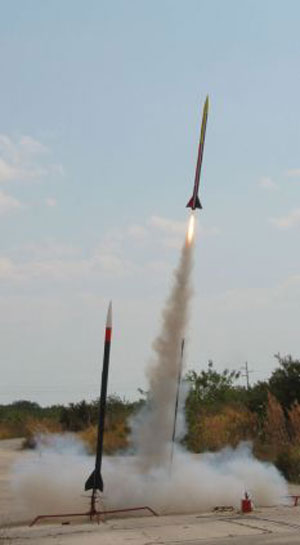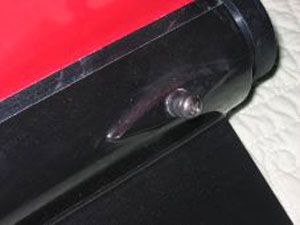| Construction Rating: | starstarstarstarstar |
| Flight Rating: | starstarstarstarstar |
| Overall Rating: | starstarstarstarstar |
| Manufacturer: | Public Missiles  |
 Brief:
Brief:
The PML Phobos is an easy to build single stage, single motor 3FNC MPR/HPR kit. It could be used for Level 1 certifications but I don't know if I would recommend it for that. You have a choice of either Quantum or phenolic tubing and 29mm or 38mm motor mount.
Construction:
I bought the kit direct from PML with the Quantum tubing (QT) and 38mm motor mount. My goal in picking the Phobos was that it was going to be easy to build, a stable design, and that I could fly it on a G before attempting my Level 1 certification with it.
I used 12 minute epoxy for the entire build. The build went without any major issues, however, I want to point out 4 potential "gotchas" when building a PML kit stock with the QT:
- You must sand the QT near the fin slots so that the epoxy has something to "bite" into.
- Same goes for where the launch lugs are attached.
- When epoxying the the MMT tube, after epoxying on the piston strap, make sure that the strap is not in the way of the fin placement.
- Sand the piston coupler so that you have a smooth (almost loose) travel in the QT. Patience & "elbow grease" is needed here as it might take a while to get the proper fit.
I did not make any serious modifications, but I did do the following outside the scope of the kit instructions:
 Foamed the fin can with PML expanding foam. There is maybe 1/4" gap between the QT & MMT tubes. Rather than apply epoxy fillets in such a small space, it was easier & faster to dump the foam in and sand to shape.
Foamed the fin can with PML expanding foam. There is maybe 1/4" gap between the QT & MMT tubes. Rather than apply epoxy fillets in such a small space, it was easier & faster to dump the foam in and sand to shape.- Added rail buttons. I did not however drill them into the QT. Instead I built standoffs with popcicle sticks and mounted the rail button there (see railbutton.com for more information on doing this).
- The aft centering ring was too small to add Kaplow clips or the PML retainer. I purchased and installed an AeroPack retainer and 38-29 motor adapter. (Overkill, I know!) Special note about the AeroPack retainer: I did a dry test fit. It was so snug that I was (and still am) unable to get it back off! That's not a bad thing though...
 Finishing:
Finishing:
Many people have touted the ease of finishing the PML QT and you can count me among the satisfied customers. It is indeed easy to work with. Scuff the entire rocket with 220 grit, prime with Krylon primer, sand with 320 or 400, spray with Krylon gloss colors. Where the different colors meet on my paint scheme, I covered them with 1/4" wide chrome automotive pinstriping. The chrome pinstriping has great reflectivity (my main goal) but lacks the stretchy characteristics of typical pinstriping. I did not have any notable problems with the finishing process.
Construction Rating: 5 out of 5
Flight:
I did 2 test flights on G motors. First was a single use G40-7W. I built up a good tape thrust ring, loaded the motor up in the AeroPack 38-29 adapter, slid everything into the motor mount,and screwed down the retainer cap. I had a lot of jitters for this being the largest rocket I'd ever built and launched at the time but it lifted off without a hitch. Estimated altitude of 1100ft but the delay was a good 3 seconds too long. I had a rapidly sinking feeling in my stomach as the rocket plummetted from the sky, however, it did (finally) eject at about 400 feet. No zipper or any other damage whatsoever. I couldn't believe it!
Second flight was a couple of months later on an EconoJet G35-4W. Altitude was slightly lower (~1000ft) but ejection was right at apogee. Perfect flight all the way around.
My club was finally able to have a vendor onsite at a launch for the third flight of my Phobos. I prepped a Pro38 2-grain H153, shaving 3 seconds off the delay (for a total delay of 10 seconds). Preparation was even easier this time because I didn't need to add a masking tape thrust ring and/or use the motor adapter--just slide in the motor and screw on the cap. What blew my socks off though is that the Phobos lifted off with significantly greater velocity! It darn near disappeared in the sky... Some of the more experienced fliers in my club estimated that it was well over a half-mile up! It was fairly windy that day so it did drift on the way down. After a 45 minute search, I finally stumbled upon it and everything was intact! I'd just become certified Level 1.
Recovery:
Pistons are a technology that people either love or hate. I have had nothing but success with my Phobos and particularly enjoy that I don't need to use any wadding. Cleaning out the body tube at least every other flight and always making sure that the piston fits loosely are the key points to remember. If I ever build another PML kit, and it's quite likely, I would build it stock with the piston again.
The stock chute is a PML 30" with spill hole. Drifting isn't too bad and the descent rate is fairly quick. According to PML's parachute FAQ, the Phobos it towards the heavy end of recommended weights for their 30" chute, which explains my quick descents. And it's a good thing that I launch at sites where it's all but guaranteed a soft, grassy landing! However, if I were launching at a site with hard surfaces, I wouldn't think twice to swap it out for a larger chute. The kit is durable and would probably sustain a reasonable impact with very little if any damage though thanks to the high quality parts in the kit.
Flight Rating: 5 out of 5
Summary:
With the 38mm MMT, I have a wide range of 29mm & 38mm motors to chose from since the Phobos will fly on as little as a G, really performs with an H, and probably can wish it good-bye on an I. (According to RockSim, a Phobos with phenolic tubing & fiberglassed could break Mach on as little as a I435T.) Despite that flexibility of motor choices and the nearly perfect results I've had, in hindsight I don't know if I would recommend it as a good kit to cert Level 1 on. I would instead recommend a kit with a larger diameter so that the cert flight would be "slow and low". After you get that certification though, you sure could let 'er rip with the Phobos!
Overall Rating: 5 out of 5
Other Reviews
- Public Missiles Phobos By Aaron Stanley
The Public Missiles, Ltd. Phobos is one of the great, easy to build mid and high power rockets out there you can buy. This rocket can be launched on any where from a F40 all the way up to a J570 if you get it with the 38mm motor mount. This is probably the best rocket to use for your Level 1 cert attempt, which I used it for. The only down side to this kit is you have to clean out the main ...
- Public Missiles Phobos By Brian Kain
( Contributed - by Brian Kain - 10/15/00) Brief: I shortened the span of the fins to 2.25". Used 1/4" graphite tubing for launch lugs. Modifications: I took the three (3) fins and put them in my flat jaw vice, making sure to keep them all straight and lined up. Then with my dremel tool and a carbon cutting wheel, I cut all 3 fins at once. Then kept them in the vice ...
- Public Missiles Phobos By Michael Veno
Picture courtesy of Public Missiles Brief: The PML Phobos is a 2.15" HPR with payload section. I selected it because PML website indicated that is was capable of flying with a J350. This would allow me to use it for both for a TRA Level 1 certification as well as Level 2. Construction: The PML Phobos is a 2.15", 57” long HPR with payload section using the PML ...
 |
 |
Flights
 |
 |
R.D. (October 1, 2000)
L.A. (October 31, 2003)
 |
 |
K.B. (June 1, 2000)